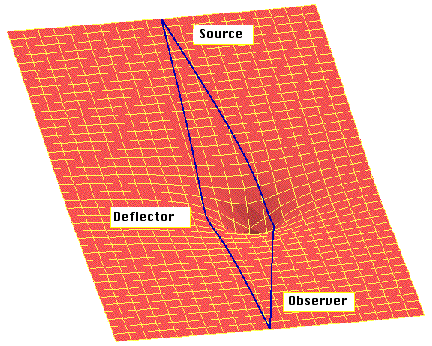Quads to doubles: a probe of substructure
Over 70 galaxy strong gravitational lenses have been discovered.
These occur when light from a faraway source, such as a high
redshift quasar, gets bent so much by the matter of a galaxy
that it passes en route to earth that multiple images are produced.
Lensing depends only on the bending of the path of the light by
matter, so it measures the dark matter content of the galaxies in a way
that dynamical estimates (which require equilibrium assumptions) cannot.
With the CASTLES and CLASS surveys, we are beginning to get
extremely useful
statistical samples of these intervening galaxies, which have average
redshifts around 0.7.
 (figure by Campbell, Datta, Gorelik, Herrmann, Troyani, source page
here)
(figure by Campbell, Datta, Gorelik, Herrmann, Troyani, source page
here)
A "standard model" of galaxy structure is emerging from analysis
of specific lenses which have many images and
the sampe of known lenses as a whole. In particular,
galaxies which lens seem to have density
~ r-2 and some flattening (ellipticity).
Puzzle
Within this picture a puzzle has emerged over the last few years.
Most lensed systems have either two or four images (doubles and
quads respectively).
Here are two examples:

|

|
| the
"quad"
B1422, a redshift 0.3 galaxy (source,
CASTLES) |
the "double" B2114, another redshift 0.3 galaxy
(source,
CASTLES)
|
The number of images found depends upon the properties of the galaxy
and the position of the source, if the light from the source passes
by the galaxy in certain regions of space a quad will arise, while
in other regions a double will arise. Below is a picture of regions
near a galaxy which will produce quads or doubles. The galaxy is
taken to have the average amount of ellipticity or flattening.

|
Regions behind a galaxy and image multiplicities:
A source behind regions in RED produces
a "double"
A source behind regions in YELLOW produces
a "quad"
The galaxy is centered in the middle of the plot and is flattened in
the vertical direction, with ellipticity 0.3.
|
Using this standard model and taking into account biases, one can predict
the relative numbers of quads to doubles found in a homogeneous sample,
such as the CLASS survey, which was completed recently. The expected
number is about 1 quad for every 4 doubles, while the actual observed
number is closer to 2 to 5, ie about twice as many quads as expected.
A way out: substructure predicted by
hierarchical structure formation
The Cold Dark Matter paradigm of structure formation begins with small
objects clumping together to form larger ones which in turn clump together
to form even larger ones. Thus, near and within any structure there
will be smaller mass objects, which can also lens. Thus instead of
considering an isolated galaxy, one should include the effects of
lensing from the combined system. Below is an example of what happens
to multiplicites when the galaxy given above has
another galaxy "nearby".

|
Regions behind a galaxy and image multiplicities:
A source behind regions in RED produces
a "double"
A source behind regions in YELLOW produces
a "quad"
A source behind regions in GREEN produces
a "five"
The position of the satellite and the galaxy are given in blue.
The galaxy above now has another galaxy "nearby"
(i.e. somewhere between us and its source), whose mass is about
2/3 of that of the larger galaxy.
|
Solution?
Adding up the contributions of having a nearby galaxy can increase the
number of quads significantly, getting close to the doubling needed in
order to match the data (J. Cohn and C. Kochanek,
astro-ph.0306171).
This research was supported in part by NSF-AST-0205935. Opinions
stated here do not reflect those of NSF.
 (figure by Campbell, Datta, Gorelik, Herrmann, Troyani, source page
here)
(figure by Campbell, Datta, Gorelik, Herrmann, Troyani, source page
here)



